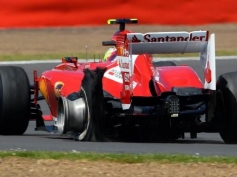LA EXPLICACION OFICIAL
Luego de un Gran Premio de Silverstone accidentado por varias roturas de los neumáticos, Pirelli envió ayer un comunicado oficial explicando el por que de tantas fallas sucedidas en carrera.
-
- Compartir

La explicación de Pirelli sobre los hechos de Silverstone y las próximas carreras
UNA SERIE DE DIFERENTES CAUSAS PRODUJERON LAS FALLAS EN LOS NEUMÁTICOS EN SILVERSTONE: LOS NEUMÁTICOS TRASEROS MONTADOS AL REVES, LA BAJA PRESIÓN DE NEUMÁTICOS LAS EXTREMAS CURVATURAS Y BORDILLOS ALTOS
LOS NEUMÁTICOS 2013 NO PONEN EN RIESGO LA SEGURIDAD SI SON UTILIZADOS CORRECTAMENTE
PARA DESARROLLAR Y MANEJAR SOFISTICADOS NEUMÁTICOS COMO LOS DE 2013, ES ESENCIAL TENER ACCESO A INFORMACIÓN EN TIEMPO REAL. SE SOLIciTAN CAMBIOS EN LAS REGLAS.
EL CINTURON KEVLAR DE NEUMÁTICOS TRASEROS USADOS EN LA PRÁCTICA LIBRE DE CANADÁ SERÁ UTILIZADO EN ALEMANIA
A PARTIR DE HUNGRÍA HABRÁ UN NUEVO RANGO DE NEUMÁTICOS, QUE COMBINAN LA ESTRUCTURA DE LOS NEUMÁTICOS 2012 CON LOS COMPUESTOS DE 2013.
PAUL HEMBERY: “NOS MOLESTÓ LO QUE SUCEDIÓ EN SILVERSTONE. CON ESTOS SOFISTICADOS NEUMATICOS ES VITAL ANALIZAR INFORMACIÓN DE LA TEMPERATURA, LA PRESIÓN Y LA CURVATURA. MIENTRAS ESPERAMOS LA REVISIÓN DE LAS REGLAS, PROVEEREMOS NEUMÁTICOS MÁS FÁCILES DE MANEJAR”
Tras un análisis exhaustivo de los neumáticos utilizados en Silverstone, Pirelli concluyó que las causas de las fallas se produjeron por una combinación de los siguientes factores:
1) Los neumáticos traseros fueron mal colocados.
2) La presión de los neumáticos estaba excesivamente baja.
3) El uso extremo de ángulos de curvatura.
4) El bordillo era particularmente agresivo en las esquinas rápidas.
Mirá también...
-

TOPRAK RAZGATLIOGLU TRICAMPEON DE...
Máxima velocidad 19 de Octubre -

NUEVO PODIO PARA ESTEBAN GUERRIERI EN...
Máxima velocidad 19 de Octubre -

RAUL FERNANDEZ FESTEJO POR PRIMERA VEZ...
Máxima velocidad 19 de Octubre -

MORELLI TERMINO 18, PERRONE 22 Y FUE...
Máxima velocidad 19 de Octubre -

MAX VERSTAPPEN FUE EL POLEMAN EN...
Máxima velocidad 18 de Octubre -

MATIAS CANAPINO, EL POLEMAN DE LA...
Máxima velocidad 18 de Octubre





